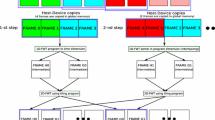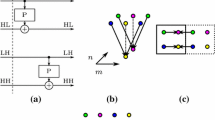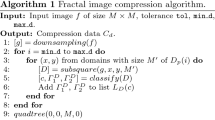Abstract
In this paper, we introduce and evaluate the parallel implementations of two video sequences decorrelation algorithms having been developed based on the non-alternating three-dimensional wavelet transform (3D-WT) and the temporal-window method. The proposed algorithms have been proven to outperform the classic 3D-WT algorithm in terms of a better coding efficiency and lower computational requirements while enabling a lossless coding and a top-quality reconstruction: the two most highly relevant features to medical imaging applications. The parallel implementations of the algorithms are developed and tested on a shared memory system, a SGI Origin 3800 supercomputer, making use of a message-passing paradigm. We evaluate and analyze the performance of the implementations in terms of the response time and speed-up factor by varying the number of processors and various video coding parameters. The key point enabling the development of highly efficient implementations rely on a workload distribution strategy supplemented by the use of parallel I/O primitives, for better exploiting the inherent features of the application and computing platform. Two sets of I/O primitives are tested and evaluated: the ones provided by the C compiler and the ones belonging to the MPI/IO library.















Similar content being viewed by others
References
Feil, M., & Uhl, A. (2002). Efficient wavelet-based video coding. IEEE International Parallel and Distributed Processing Symposium, IPDPS.
Nielsen, O. M., & Hegland, M. (2000). Parallel performance of fast wavelet transform. International Journal of High Speed Computing, 11(1), 55–73.
Moyano-Ávila, E., Quiles, F. J. & Orozco-Barbosa, L. (2006). Standard wavelet transform for angiography sequences decorrelation by the temporal-window method. World Congress on Medical Physics and Biomedical Engineering, Springer Series, pp. 2472–2475.
Moyano, E., Quiles, F. J., Garrido, A., Orozco-Barbosa, L., Duato, J. (2001). Efficient 3-D wavelet transform decomposition for video compression. Second International Workshop on Digital and Computational Video, USA, IEEE Computer Society, pp. 118–125.
Moyano-Ávila, E., Orozco-Barbosa, L., & Quiles, F. J. (2007). Entropy improvement by the temporal-window method for alternating and non-alternating 3D wavelet transform over angiographies. Journal of Medical and Biological Engineering and Computing, 45(11), 1121–1125.
Fournier, A. (1995) Wavelets and their application in computer graphics. Siggraph Course Notes.
Pearlman, W. A., Kim, B. J., & Xiong, Z. (1998). Embedded video subband coding with 3D SPIHT. Wavelet image and video compression. Dordrecht: Kluwer.
Moving Picture Experts Group (MPEG). Working group of ISO/IEC. http://www.chiariglione.org/mpeg/.
Pacheco, P. (1997). Parallel programming with MPI. San Francisco, CA: Morgan Kaufmann Publishers, Inc.
Thakur, R. (2005). Introduction to parallel I/O and MPI-IO, Tutorial at 11th Annual Computing Institute. California: San Diego Supercomputer Center.
Mallat, S. G. (1989). Multifrequency channel decompositions of images and wavelet models. IEEE Transactions on Acoustics, Speech and Signal Processing, 37(12), 2091–2110.
Antonini, M., Barlaud, M., Mathieu, P., & Daubechies, I. (1992). Image coding using wavelet transform. IEEE Transactions on Image Processing, 1, 205–220.
Komatsu, K., & Sezaki, K. (1999). Lossless filter banks based on two point transform and interpolative prediction. Proceedings of IEEE International Conference on Acoustics, Speech, and Signal Processing, 3, 1469–1472.
Moyano-Ávila, E., Quiles, F.J., Orozco-Barbosa, L. (2007). Development and evaluation of high-performance decorrelation algorithms for the nonalternating 3D wavelet transform. EURASIP Journal on Advances in Signal Processing, Vol. 2007. Hindawi Publishing Corporation.
Modarresi, M., & Sarbazi-Azad, H. (2005). Parallel 3-dimensional DCT computation of K-Ary n-cubes. International Conference on High-Performance Computing in Asia-Pacific Region. IEEE Computer Society.
Yu, H., & Ma, K. (2005). A study of I/O methods for parallel visualization of large-scale data. Parallel Computing, 31(2), 167–183.
Wapperom, P., Beris, A. N., & Straka, M. A. (2006). A new transpose split method for three-dimensional FFTs: Performance on an Origin2000 and Alphaserver cluster. Parallel Computing, 32(1), 1–13.
Thulasiraman, P., Khokhar, A. A., Heber, G., & Gao, G. R. (2004). A fine-grain load-adaptive algorithm of the 2D discrete wavelet transform for multithreaded architectures. Journal of Parallel and Distributed Computing, 64(1), 68–78.
Kutil, R., & Uhl, A. (1999). Hardware and software aspects for 3-D wavelet decomposition on shared memory MIMD computers. Proceedings ACPC’99, LNCS 1557, pp. 347–356.
Norcen, R., & Uhl, A. (2005). High performance JPEG 2000 and MPEG-4 VTC on SMPs using OpenMP. Parallel Computing, 31(10–12), 1082–1098.
Katona, M., Pizurica, A., Teslic, N., Kovacevic, V., & Philips, W. (2006). A real-time wavelet-domain video denoising implementation in FPGA. EURASIP Journal of Embedded Systems, 2006, 1–12.
Silicon Graphics Inc. “SGI Origin 3000”. http://www.sgi.com/origin/3000/
Acknowledgment
This work has been jointly supported by the Spanish MEC and European Comission FEDER funds under grants “Consolider Ingenio-2010 CSD2006-00046” and “TIN2006-15516-C04-02”.
Author information
Authors and Affiliations
Corresponding author
Rights and permissions
About this article
Cite this article
Moyano-Ávila, E., Orozco-Barbosa, L. & Quiles, F.J. Parallel Algorithms Based on the Temporal-Window Method for Non-Alternating 3D-WT over Angiographies Using a Multicomputer. J Sign Process Syst Sign Image Video Technol 55, 267–279 (2009). https://doi.org/10.1007/s11265-008-0188-4
Received:
Revised:
Accepted:
Published:
Issue Date:
DOI: https://doi.org/10.1007/s11265-008-0188-4




